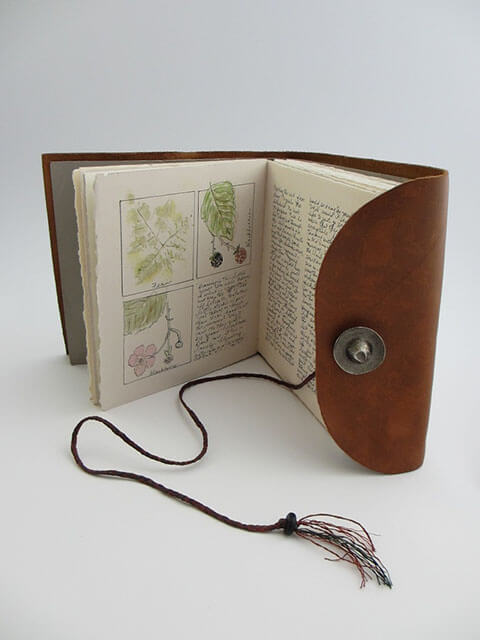This week I am teaching a book arts class for Osher Life Long Learning Institute (OLLI). The first day we will construct this book: leather covers, pages of printmaking paper, sewn longstitch spine. Day two we will explore ways to “get things” on the page. The class is this Tuesday and Thursday, 3pm-6pm. I can hardly wait, I have as much fun as the students. You can register for many inspiring, informative, and entertaining classes here.
Exposed spines are versatile, attractive, and provide opportunities to enhance the artistic qualities of the book.
My two children live in San Diego and I’m always looking for an excuse to go down to visit. I have loved Daniel Essig’s books for years and the idea that I could actually see and handle his books was reason enough to book a flight. Even better, he was offering a three day workshop to make a sewn book with wooden covers. I’ve done little sewing so I knew this was going to be a bit of a challenge. It was. However, I loved working with wood and all of the tools: drill press, power tools, hand drills, and my personal favorite, the industrial lathe tool we used to create metal posts. I enjoyed sewing the caterpillar but the stitches along the edges drove me batty (and I’m sure Daniel too). But. Now I know I can actually sew these stitches and maybe even begin to understand Keith Smith’s instructions on the same.
The covers were created using wood covered with handmade crumpled flax paper made by Bookmakers Inc.. Covers were painted with layers of milk paint, sanded to reveal the layers, and then waxed with shoe polish to add luster.
One of my favorite students in the class was the high school woodshop teacher who volunteered his beautiful and well equipped classroom for our workshop. He had no bookmaking experience and created a wonderful book with patience and good humor.
I had a three day workshop coming up with Daniel Essig so I thought it might be a good idea to assemble another book using the coptic stitch—hoping my fingers would remember what to do. I used scrap wood from my recycled wood stash (from my husband and his woodworking friends) and thought I would sew the book with one type of stitch, then cut those out and try another type of stitch. As usually happens, I got way more involved with the project than intended and ended up with a nice little book. The sunflower is a heat transfer with color smudged into the wood. The little metal frame is glued on with scientific jargon underneath. I am sending the book to a dear friend and her name and mine is burned into the inside back cover. I can always find more wood….






